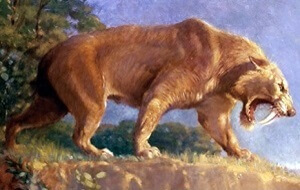Activity 1: Narrate the Chapter
- After you listen to the chapter, narrate the chapter aloud using your own words.
Activity 2: Draw Early Humans Before the Stone Age

- Click the crayon above. Complete page 3 of 'Second Grade World History Coloring Pages, Copywork, and Writing.'
Use pencils, crayons, pastels, or markers and the following description from the chapter to draw your own pictures of pre-Stone Age people.
- The great-great-grandfather of humanity was quite small.
- The heat of the sun and the biting wind of the cold winter had colored his skin a dark brown.
- His head and most of his body were covered with long hair.
- He had very thin but strong fingers which made his hands look like those of a monkey.
- His forehead was low and his jaw was like the jaw of a wild animal which uses its teeth both as fork and knife.
Activity 3: Act Out the Chapter
Gather as many of the following props as you wish to act out the story:
- Couch - for a hollow log
- Steps or countertop - for the tree holding the eggs
- Blocks or balls - for bird's eggs
- Small stuffed animal - for the animal for you to catch and eat
- Large stuffed animal - for the saber-toothed tiger trying to catch you
Instructors - read the following to the children and help them act out each line.
- Imagine you are a primitive human who lived millions of years ago, before the Stone Age began.
- Communicate using grunts and moans. You do not know how to speak words or write.
- You must find food and shelter to survive. First, find a hollow tree (couch) to sleep in. Take a nap.
- Next, wake up and hunt for something to eat. Climb a tree (steps or countertop) to rob a nest of its eggs (blocks or balls). Climb down and catch a small animal (small stuffed animal) to eat.
- Watch out! A saber-toothed tiger (large stuffed animal) is headed your way. Run and hide in your hollow tree (couch).
Activity 4: Examine the Saber-Toothed Tiger
- Study the replica of a saber-toothed tiger skeleton.
- Study the artist's rendition of a saber-toothed tiger. Imagine prehistoric man having to defend himself from the saber-toothed tiger's long fangs without modern tools or weapons.
Activity 5: Play Saber-Toothed Tiger Tag
- Play a game of tag. The one who is 'it' pretends to be a saber-toothed tiger hunting primitive people.
- The others pretend to be primitive people running for their lives.
- When the tiger catches a person, the tiger links arms with the person to simulate eating them up.
- As additional people are caught, they link arms with the previous person caught, forming a chain.
- The tiger and his chain of eaten primitive people continue hunt for more primitive people, until they are all eaten up.
Activity 6: Complete Coloring Pages, Copywork, and Writing

- Click the crayon above. Complete pages 4-5 of 'Second Grade World History Coloring Pages, Copywork, and Writing.'
Activity 7: Create a Timeline
Create a timeline for the history events studied this chapter.
- Get a large piece of paper and label it 'Origin of the Earth to the Stone Age' at the top in big letters.
- Add a dot halfway down and at the far left of the paper and label it, '4.5 Billion Years Ago - Creation of the Earth.' The distance between this mark and the other marks will not be to scale (we'd need a whole lot more paper!).
- Add two dots halfway down and to the far right of the paper and label the first, '4 to 7 Million Years Ago Humankind Becomes Bipedal.' (Bipedal means walks upright on two feet.)
- Label the second dot, '3.4 Million Years Ago Humankind Begins to Use Stone Tools.'
- Connect the dots with a long line that spans the width of the paper.
- Decorate your timeline with pictures of people, places, and things mentioned in the chapter such as the Earth, ancient people, what ancient people ate (bird's eggs, small animals, raw plants), where ancient people slept (hollow trees, groups of rocks), smoking volcanoes bubbling over with lava, great big spiders, wolves, bears, and saber-toothed tigers.
- Hang your timeline up on a wall. Make sure there is enough room to the right to expand your timeline with two additional sheets of paper.
 Ancient Man
Ancient Man
Ancient Man
Ancient Man


 Ancient Man
Ancient Man
Ancient Man
Ancient Man




